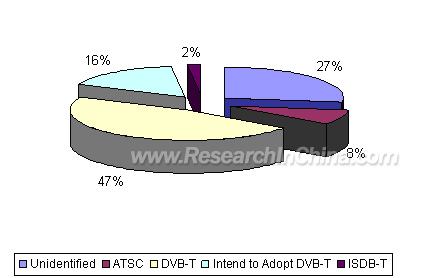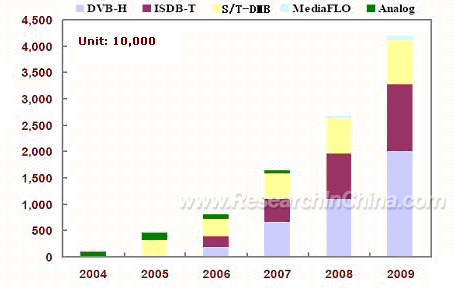This report analyses from two aspects -- non-portable receiver (vehicle mobile TV) and portable receiver (handset mobile TV) and mainly about the development of mobile TV industry and also provides some operational strategies.
The mobile TV referred in this report indicates the types adopting digital broadcasting technologies. The receiver can be fixed on bus, subway, city railway, taxi or some other public places, and it also can be fixed on hand-hold equipments, such as mobile phone, laptop, PMP, and super portable PC etc.
Most of the Areas Adopting DVB-T as Digital Terrestrial TV Standard
There are three kinds of Digital Terrestrial TV Standards: DVB-T, ATSC and ISDB-T. Most of the countries and regions in Europe adopt DVB-T; Only Japan adopts ISDB-T; North America adopts ATSC; China, Mongolia and South America have not defined their standards. There are still 16% of countries and regions intended to adopt DVB-T.
Proportion of Countries and Regions Adopting Different Digital Terrestrial TV Standards

Source:ResearchInChina
China Basically Defined the Digital Terrestrial TV Standard, but Still Takes Time before Put into Practice
Currently, the standards in China that have been industrialized are Tsinghua University's DMB-T, Shanghai Jiao Tong University's ADTB-T, Academy of Broadcasting Science's TiMi and DVB-T from Europe.
China's new standard is the integration of Tsinghua University's DMB-T, Shanghai Jiao Tong University's ADTB-T and Academy of Broadcasting Science's TiMi, which has not been officially named.
Though the standard is delayed to be issued over and over again, the Digital Terrestrial TV has been broadcasted in 43 cities. It has spread from bus, taxi to subway, railway, ferry, building and city emergency management information system. Most of these regions adopt Tsinghua University's DMB-T and DVB-T from Europe. Shanghai adopts Shanghai Jiao Tong University's ADTB-T.
Handset TV Standard Develops from DMB to DVB-H
There are two kinds of network to transmit handset TV program: one is based on mobile telecommunication network, the other is based on broadcasting network. Currently, broadcasting network develops prior to mobile telecommunication network. S/T-DMB and DVB-H standards develop faster than MediaFLO and, the development of T-DMB in Korea and China has become highlighted. MediaFLO and ISDB-T standards from America and Japan are mainly used for their own countries. Among these standards, S-DMB was the first one used for commerce and that was adopted by Korea in May 2005. Then in Dec 2005, the S-DMB was replaced by T-DMB in Korea. Handset TV based on DVB-H standard has been officially used for commerce since May 2006. Considering from the view of the world, DVB-H has great potential for development.
Figure Global Sales of TV Handsets Based on Different Standards, 2004-2009

Source: ResearchInChina
The global sales of TV handsets that supporting S-DMB standard reached 4.46 million units in 2005. It is forecasted that by the end of 2009, the global sales of TV handset will exceed 42 million units. The sales of TV handset that supporting DVB-H standard will greatly increase in the near future.
The Diversification Trend of China's Handset TV Standards, the Providers of Handset TV Solutions will take Multi-model and Multi-frequency-range as the Access to Market
In China, there will be many handset TV standards at the same time. Currently, among the three trial cities, Shanghai adopts T-DMB/L-Band frequency range; Beijing and Guangzhou adopt T-DMB/Band-III. Nokia has been looking for the opportunity to test its DVB-H handset TV standard in China. Furthermore, Tsinghua University is developing its DMB-TH standard based on DMB-T.
|



